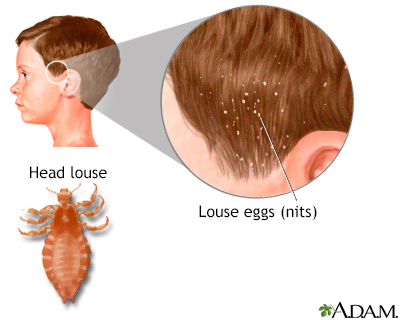Pregnancy SmartSiteTM
Pediculosis capitis - head lice; Cooties - head lice DefinitionHead lice are tiny insects that live on the skin covering the top of your head (scalp). Head lice may also be found in the eyebrows and eyelashes. Lice spread by close contact with other people. CausesHead lice infect hair on the head. Tiny eggs on the hair may look like flakes of dandruff. However, instead of flaking off the scalp, they stay in place. Head lice can live up to 30 days on a human. Their eggs can live for more than 2 weeks. Head lice spread easily, particularly among school children ages 3 to 11 years. Head lice are more common in close, overcrowded living conditions. You can get head lice if:
Having head lice causes intense itching but does not lead to serious medical problems. Unlike body lice, head lice never carry or spread diseases. Having head lice does not mean the person has poor hygiene or low social status. SymptomsSymptoms of head lice include:
Exams and TestsHead lice can be hard to see. You need to look closely. Use disposable gloves and look at the person's head under a bright light. Full sun or the brightest lights in your home during daylight hours work well. A magnifying glass can help. To look for head lice:
Both children and adults should be treated right away if any lice or eggs are found. TreatmentLotions and shampoos containing 1% permethrin (Nix) often work well. You can buy these medicines at the store without a prescription. If these products do not work, a health care provider can give you a prescription for stronger medicine. Always use the medicines exactly as directed. Using them too often or in the wrong way can cause side effects. To use the medicine shampoo:
You also need to get rid of the lice eggs (nits) to keep lice from coming back. To get rid of nits:
When treating head lice, wash all clothes and bed linens in hot water with detergent. This also helps prevent head lice from spreading to others during the short period when head lice can survive off the human body. Ask your provider if people who share bedding or clothes with the person who has head lice need to be treated as well. Outlook (Prognosis)Most of the time, lice are killed with the proper treatment. However, lice can come back if you do not get rid of them at the source. Possible ComplicationsSome people will develop a skin infection from scratching. Antihistamines can help ease itching. When to Contact a Medical ProfessionalContact your provider if:
PreventionSome of the steps to prevent head lice are:
ReferencesBurkhart CN, Burkhart GG, Morrell DS. Infestations. In: Bolognia JL, Schaffer JV, Cerroni L, eds. Dermatology. 5th ed. Philadelphia, PA: Elsevier; 2024:chap 84. James WD, Elston DM, Treat JR, Rosenbach MA, Neuhaus IM. Parasitic infestations, stings, and bites. In: James WD, Elston DM, Treat JR, Rosenbach MA, Neuhaus IM, eds. Andrew's Diseases of the Skin Clinical Dermatology. 13th ed. Philadelphia, PA: Elsevier; 2020:chap 20. Seifert SA, Dart RC, White J. Envenomation, bites, and stings. In: Goldman L, Cooney KA, eds. Goldman-Cecil Medicine. 27th ed. Philadelphia, PA: Elsevier; 2024:chap 98. | ||
| ||
Review Date: 2/17/2024 Reviewed By: Charles I. Schwartz, MD, FAAP, Clinical Assistant Professor of Pediatrics, Perelman School of Medicine at the University of Pennsylvania, General Pediatrician at PennCare for Kids, Phoenixville, PA. Also reviewed by David C. Dugdale, MD, Medical Director, Brenda Conaway, Editorial Director, and the A.D.A.M. Editorial team. View References The information provided herein should not be used during any medical emergency or for the diagnosis or treatment of any medical condition. A licensed medical professional should be consulted for diagnosis and treatment of any and all medical conditions. Links to other sites are provided for information only -- they do not constitute endorsements of those other sites. No warranty of any kind, either expressed or implied, is made as to the accuracy, reliability, timeliness, or correctness of any translations made by a third-party service of the information provided herein into any other language. © 1997- A.D.A.M., a business unit of Ebix, Inc. Any duplication or distribution of the information contained herein is strictly prohibited. | ||


 Head lice
Head lice Nit on human hair
Nit on human hair Head louse emergin...
Head louse emergin... Head louse, male
Head louse, male Head louse - femal
Head louse - femal Head louse infesta...
Head louse infesta... Lice, head - nits ...
Lice, head - nits ...
